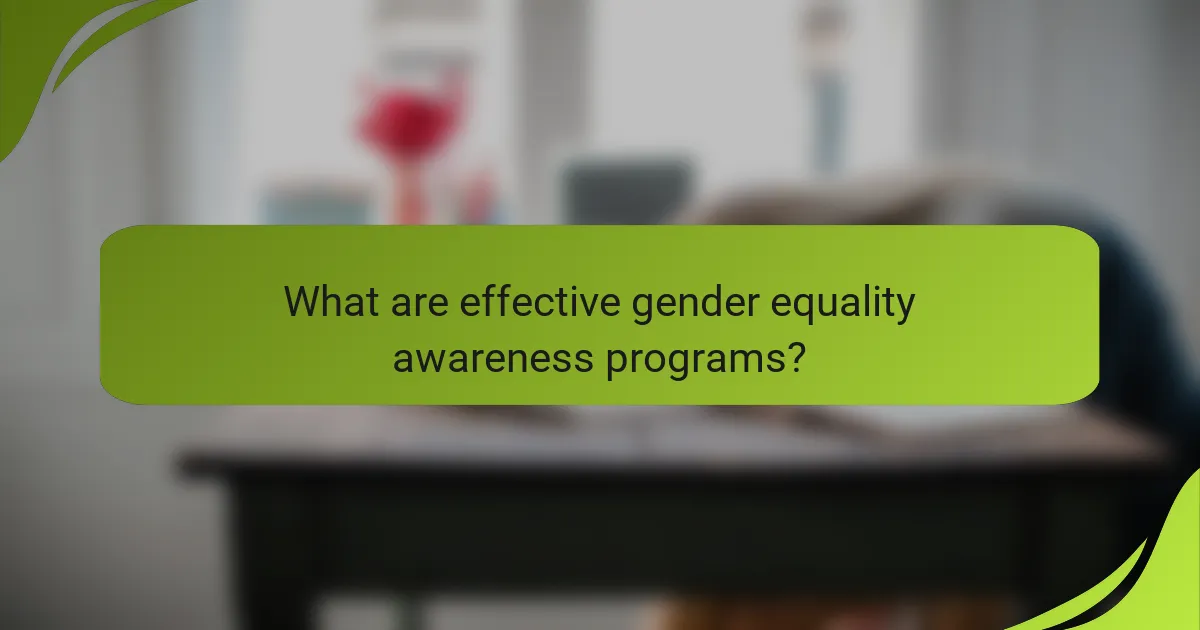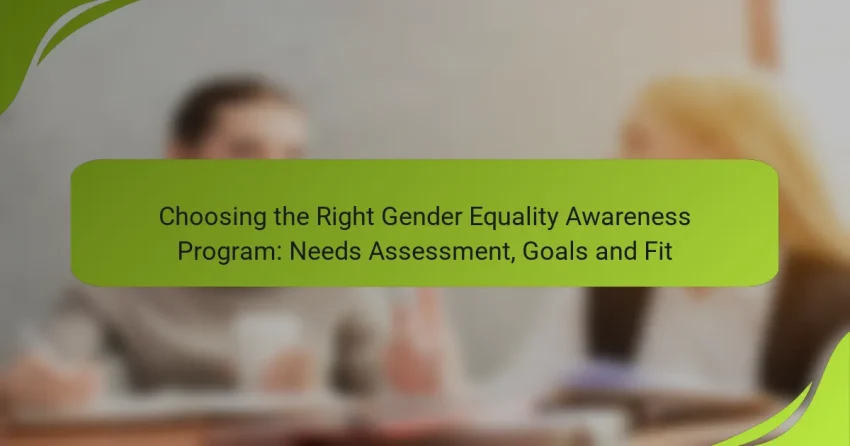Choosing the right gender equality awareness program requires a thorough needs assessment to identify specific challenges within a community. By aligning the program’s goals with these needs, organizations can create targeted initiatives that effectively promote understanding and action towards gender equality. Ultimately, a well-structured program not only raises awareness but also empowers marginalized communities and fosters inclusive practices across various sectors.

What are effective gender equality awareness programs?
Effective gender equality awareness programs are structured initiatives aimed at promoting understanding and action towards gender equality. These programs often include educational components, community engagement, and advocacy efforts to address gender disparities in various sectors.
UN Women Gender Equality Program
The UN Women Gender Equality Program focuses on empowering women and promoting gender equality globally. It provides resources and frameworks for governments and organizations to implement policies that support women’s rights and gender equity.
Key components of this program include capacity building, advocacy for legal reforms, and partnerships with local organizations. For instance, countries can adopt gender-responsive budgeting to ensure that financial resources are allocated to initiatives that support women’s empowerment.
HeForShe Campaign
The HeForShe Campaign is a solidarity movement initiated by UN Women, encouraging men and boys to advocate for gender equality. This program emphasizes the role of men in challenging gender stereotypes and promoting equitable practices in their communities.
Participants can engage through various activities, such as workshops, social media campaigns, and community events. The campaign aims to create a global movement where men actively support women’s rights, fostering a culture of equality.
Global Fund for Women Initiatives
The Global Fund for Women supports initiatives that advance women’s rights and gender equality worldwide. It provides grants to grassroots organizations working on issues like reproductive rights, economic empowerment, and violence against women.
By funding local projects, the Global Fund ensures that initiatives are culturally relevant and address specific community needs. Organizations can apply for funding to implement programs that directly impact women’s lives, such as education and health services, which are crucial for achieving gender equality.

How to assess needs for gender equality programs?
Assessing needs for gender equality programs involves identifying the specific challenges and gaps within a community. This process ensures that the programs developed are relevant, targeted, and effective in promoting gender equality.
Conduct stakeholder interviews
Stakeholder interviews are a vital tool for gathering qualitative insights about gender equality needs. Engage with a diverse group of stakeholders, including community leaders, local organizations, and individuals affected by gender disparities. Aim for a mix of perspectives to uncover nuanced issues and potential solutions.
Prepare open-ended questions that encourage discussion about personal experiences and observed challenges. This approach can reveal underlying attitudes and beliefs that may not surface in quantitative data.
Utilize surveys for community feedback
Surveys can efficiently gather quantitative data on community perceptions and experiences related to gender equality. Design surveys that include a mix of multiple-choice and open-ended questions to capture a broad range of feedback. Consider distributing surveys both online and in-person to reach various demographics.
Ensure that the survey is accessible and culturally sensitive, using language that resonates with the community. Analyze the results to identify trends and prioritize areas for intervention, keeping in mind that feedback should guide program development and implementation.

What goals should a gender equality program have?
A gender equality program should aim to raise awareness of gender issues, promote inclusive practices, and empower marginalized communities. These goals help create a more equitable environment in workplaces and society at large.
Increase awareness of gender issues
Raising awareness of gender issues involves educating participants about the various forms of gender inequality and their impacts. This can include workshops, seminars, and discussions that highlight topics such as pay gaps, representation, and gender-based violence.
Effective programs often use real-life case studies and data to illustrate the prevalence of these issues. For example, organizations might share statistics showing that women earn significantly less than men in similar roles, which can spark important conversations.
Promote inclusive workplace practices
Inclusive workplace practices ensure that all employees feel valued and respected, regardless of gender. This can involve implementing policies that support work-life balance, such as flexible working hours and parental leave.
Training sessions on unconscious bias can also help staff recognize and mitigate their biases, fostering a more inclusive culture. Companies might consider establishing diversity committees to oversee these initiatives and track progress.
Empower marginalized communities
Empowering marginalized communities involves providing resources and opportunities for those who have been historically disadvantaged. This could include mentorship programs, scholarships, and networking opportunities specifically aimed at underrepresented groups.
Collaboration with local organizations can enhance these efforts, ensuring that programs are tailored to the specific needs of the community. For instance, partnering with women’s shelters can help address the unique challenges faced by survivors of domestic violence.

How to determine the fit of a gender equality program?
To determine the fit of a gender equality program, assess how well it aligns with your organization’s values, goals, and existing culture. A suitable program should not only address gender equality issues but also resonate with the mission and vision of your organization.
Align with organizational values
Ensuring that a gender equality program aligns with your organizational values is crucial for its success. Start by reviewing your organization’s mission statement and core principles to identify key themes related to equality, diversity, and inclusion.
For example, if your organization prioritizes innovation and collaboration, choose a program that encourages diverse perspectives and teamwork. This alignment fosters employee buy-in and enhances the program’s effectiveness.
Evaluate program scalability
Assessing the scalability of a gender equality program is essential for long-term sustainability. Consider whether the program can be expanded or adapted to meet the changing needs of your organization as it grows.
Look for programs that offer flexible modules or resources that can be tailored to different departments or employee levels. For instance, a program that includes training sessions for various team sizes or formats can better accommodate future growth.

What frameworks aid in selecting gender equality programs?
Frameworks such as the Logic Model and SMART Goals are essential tools for selecting effective gender equality awareness programs. They help organizations define objectives, measure outcomes, and ensure alignment with community needs.
Logic Model Framework
The Logic Model Framework provides a visual representation of how a program is intended to work. It outlines inputs, activities, outputs, outcomes, and impacts, making it easier to understand the relationship between resources and results.
When using this framework, start by identifying the resources available for your gender equality program, such as funding, personnel, and materials. Next, define the activities you will implement and the expected outputs, like workshops or training sessions. Finally, clarify the short-term and long-term outcomes you aim to achieve, such as increased awareness or behavioral changes.
SMART Goals Framework
The SMART Goals Framework is a method for setting clear and achievable objectives. SMART stands for Specific, Measurable, Achievable, Relevant, and Time-bound, ensuring that goals are well-defined and attainable within a set timeframe.
To apply this framework, begin by crafting specific goals related to your gender equality program, such as increasing participation in training sessions by a certain percentage. Make sure these goals are measurable, allowing you to track progress. Ensure they are achievable and relevant to your target audience, and establish a timeline for completion to maintain focus and accountability.

What are the challenges in implementing gender equality programs?
Implementing gender equality programs often faces several challenges, including organizational resistance, lack of resources, and insufficient training. These obstacles can hinder the effectiveness of initiatives aimed at promoting equality in the workplace.
Resistance to change in organizations
Resistance to change is a significant barrier when introducing gender equality programs. Employees and management may be accustomed to existing norms and practices, making them reluctant to adopt new policies or initiatives.
To address this resistance, organizations should engage stakeholders early in the process. Conducting workshops and discussions can help clarify the benefits of gender equality and foster a culture of inclusivity. Providing data on how gender equality can enhance productivity and morale may also facilitate acceptance.
Additionally, it is crucial to identify change champions within the organization who can advocate for the program. These individuals can help influence their peers and create a supportive environment for the implementation of gender equality initiatives.
